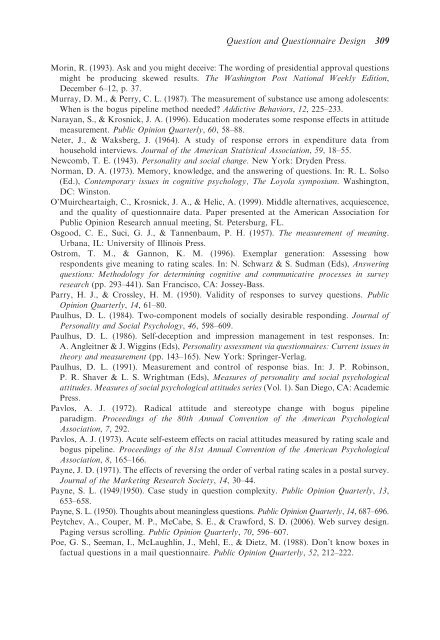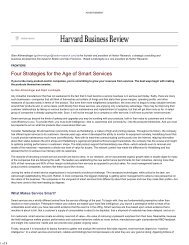Question and Questionnaire Design - Stanford University
Question and Questionnaire Design - Stanford University
Question and Questionnaire Design - Stanford University
You also want an ePaper? Increase the reach of your titles
YUMPU automatically turns print PDFs into web optimized ePapers that Google loves.
<strong>Question</strong> <strong>and</strong> <strong>Question</strong>naire <strong>Design</strong> 309Morin, R. (1993). Ask <strong>and</strong> you might deceive: The wording of presidential approval questionsmight be producing skewed results. The Washington Post National Weekly Edition,December 6–12, p. 37.Murray, D. M., & Perry, C. L. (1987). The measurement of substance use among adolescents:When is the bogus pipeline method needed? Addictive Behaviors, 12, 225–233.Narayan, S., & Krosnick, J. A. (1996). Education moderates some response effects in attitudemeasurement. Public Opinion Quarterly, 60, 58–88.Neter, J., & Waksberg, J. (1964). A study of response errors in expenditure data fromhousehold interviews. Journal of the American Statistical Association, 59, 18–55.Newcomb, T. E. (1943). Personality <strong>and</strong> social change. New York: Dryden Press.Norman, D. A. (1973). Memory, knowledge, <strong>and</strong> the answering of questions. In: R. L. Solso(Ed.), Contemporary issues in cognitive psychology, The Loyola symposium. Washington,DC: Winston.O’Muircheartaigh, C., Krosnick, J. A., & Helic, A. (1999). Middle alternatives, acquiescence,<strong>and</strong> the quality of questionnaire data. Paper presented at the American Association forPublic Opinion Research annual meeting, St. Petersburg, FL.Osgood, C. E., Suci, G. J., & Tannenbaum, P. H. (1957). The measurement of meaning.Urbana, IL: <strong>University</strong> of Illinois Press.Ostrom, T. M., & Gannon, K. M. (1996). Exemplar generation: Assessing howrespondents give meaning to rating scales. In: N. Schwarz & S. Sudman (Eds), Answeringquestions: Methodology for determining cognitive <strong>and</strong> communicative processes in surveyresearch (pp. 293–441). San Francisco, CA: Jossey-Bass.Parry, H. J., & Crossley, H. M. (1950). Validity of responses to survey questions. PublicOpinion Quarterly, 14, 61–80.Paulhus, D. L. (1984). Two-component models of socially desirable responding. Journal ofPersonality <strong>and</strong> Social Psychology, 46, 598–609.Paulhus, D. L. (1986). Self-deception <strong>and</strong> impression management in test responses. In:A. Angleitner & J. Wiggins (Eds), Personality assessment via questionnaires: Current issues intheory <strong>and</strong> measurement (pp. 143–165). New York: Springer-Verlag.Paulhus, D. L. (1991). Measurement <strong>and</strong> control of response bias. In: J. P. Robinson,P. R. Shaver & L. S. Wrightman (Eds), Measures of personality <strong>and</strong> social psychologicalattitudes. Measures of social psychological attitudes series (Vol. 1). San Diego, CA: AcademicPress.Pavlos, A. J. (1972). Radical attitude <strong>and</strong> stereotype change with bogus pipelineparadigm. Proceedings of the 80th Annual Convention of the American PsychologicalAssociation, 7, 292.Pavlos, A. J. (1973). Acute self-esteem effects on racial attitudes measured by rating scale <strong>and</strong>bogus pipeline. Proceedings of the 81st Annual Convention of the American PsychologicalAssociation, 8, 165–166.Payne, J. D. (1971). The effects of reversing the order of verbal rating scales in a postal survey.Journal of the Marketing Research Society, 14, 30–44.Payne, S. L. (1949/1950). Case study in question complexity. Public Opinion Quarterly, 13,653–658.Payne, S. L. (1950). Thoughts about meaningless questions. Public Opinion Quarterly, 14, 687–696.Peytchev, A., Couper, M. P., McCabe, S. E., & Crawford, S. D. (2006). Web survey design.Paging versus scrolling. Public Opinion Quarterly, 70, 596–607.Poe, G. S., Seeman, I., McLaughlin, J., Mehl, E., & Dietz, M. (1988). Don’t know boxes infactual questions in a mail questionnaire. Public Opinion Quarterly, 52, 212–222.
















